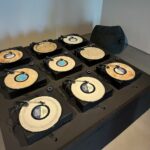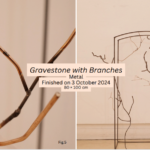Summary
Sun Xi’s blog documents her curatorial development with a strong emphasis on community memory, local history, and participatory practices. While reading her posts, I was fascinated by how she weaves together storytelling, site-specificity, and emotional connection. Her use of everyday materials and personal reflections brings a sense of warmth and care to her project. The way she applies curatorial theory to her developing practice demonstrates thoughtful engagement and a commitment to creating meaning through curating.
Strengths
One of the key strengths of Sun Xi’s work lies in her ability to integrate theory into practice. Her reference to Claire Bishop’s concept of “relational aesthetics” is well-applied in participatory components like mapping and collective storytelling. These methods are not superficial, but deeply embedded in the structure of her curatorial thinking.
She also demonstrates sensitivity in her choice of venue. The Wee Museum of Memory reflects Paul O’Neill’s idea of “distributed agency” and shows that she’s thinking beyond institutional spaces. By choosing a smaller, more emotionally resonant site, she aligns her curatorial environment with her theme of memory and community.
Additionally, I appreciate her documentation of group collaboration and research. Her tone is sincere, and the visual elements in her blog help bring her curatorial journey to life.
Weaknesses
While her curatorial concept is compelling, there are areas where I think further development would help strengthen the project. First, the curatorial theme needs clearer theoretical anchoring. Although she references key thinkers, I would suggest deepening the discussion around memory and emotion—perhaps drawing on authors like Andreas Huyssen or Sara Ahmed—to explore how affect functions in spatial design.
Second, regarding curatorial form, it’s still unclear how the exhibition components (e.g., objects, workshops, digital media) will coexist. Would the exhibition be linear, modular, or immersive? A simple diagram or floor plan could make this more understandable and provide a practical link between concept and experience.
Third, on venue selection, while the Wee Museum is intimate and appropriate, I wonder whether it provides enough technical flexibility (e.g., lighting, sound, accessibility) for more experimental or multimedia works. It may help to list alternative or backup venues, or consider co-curating across multiple spaces.
Finally, I’d encourage her to consider practical aspects like budget and ethics. For instance, how will she support artists, or handle consent and care in collecting community memories? Even speculative budgeting or ethical notes would add depth and professionalism.
Conclusion
Sun Xi’s curatorial voice is clear, caring, and rooted in personal and social memory. Her blog encouraged me to reflect on my own curatorial methods, especially in considering how small-scale, emotion-driven experiences can have significant impact. With further attention to form, logistics, and ethical framing, I believe her project will evolve into a rich and resonant exhibition. Keep developing your ideas, Sun Xi—you’ve built a strong conceptual foundation, and I look forward to seeing your curatorial vision take shape.
References
1.Bishop, Claire. Artificial Hells: Participatory Art and the Politics of Spectatorship. London: Verso, 2012.
2.O’Neill, Paul. The Culture of Curating and the Curating of Culture(s). Cambridge, MA: MIT Press, 2012.
3.Rogoff, Irit. “Turning.” In Curating and the Educational Turn, edited by Paul O’Neill and Mick Wilson, 32–46. Amsterdam: Open Editions/De Appel, 2010.
4.Hantelmann, Dorothea von. How to Do Things with Art: The Meaning of Art’s Performativity. Zurich: JRP|Ringier, 2010.
5.Ahmed, Sara. The Cu**ltural Politics of Emotion. Edinburgh: Edinburgh University Press, 2004.
6.Huyssen, Andreas. Present Pasts: Urban Palimpsests and the Politics of Memory. Stanford: Stanford University Press, 2003.




